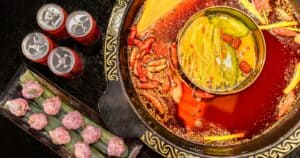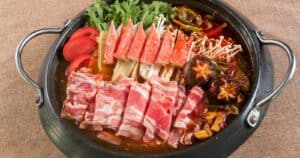Craving the fun and flavors of hot pot but unsure whether to go for Chinese or Taiwanese style? With bubbling broths, thinly sliced meats and veggies, hot pot lets you cook a meal right at the table – but key differences exist between the Chinese and Taiwanese versions.
Chinese hot pot focuses on the spicy, numbing heat of Sichuan peppercorn and chilies. The broth is typically a fiery red color, meant to make you sweat. It highlights beef, tripe or fatty lamb. Taiwanese hot pot takes a more herbal route, with medicinal Chinese herbs and mild seafood broths. Taiwanese hotpot also includes higher end ingredients like lobster or shrimp. You dip everything from tofu puffs to dumplings into the shared pot.
Both versions offer interactive dining and mouthwatering flavors. But Taiwanese hot pot takes a lighter approach, while Chinese hot pot turns up the heat. Knowing the differences helps you decide which bubbling hot pot suits your tastes. Don’t just settle for any hot pot – seek out the authentic Sichuan or Taiwanese experience. Let the simmering broth warm your soul as you savor the distinctive flavors of each style.
Chinese Hot Pot: Turning Up the Heat
Chinese hot pot focuses on numbing heat. The signature flavor comes from tongue-tingling Sichuan peppercorns and spicy chilies.
Fiery Broths
Chinese hot pot broths pack some serious heat:
- Sichuan Style – This red broth contains chili oil and mouth-numbing Sichuan peppercorn. It’s intensely spicy and aromatic.
- Mala Broth – “Mala” means the dual sensation of spicy and numbing. Chili pepper and Sichuan peppercorn create this flavor profile.
- Clear Broth – A lighter broth alternative, but still infused with peppers and Sichuan spices. Has a transparent appearance.
Hearty Ingredients
Meats and veggies that hold up well to spicy broths are emphasized:
- Fatty beef like ribeye
- Lamb
- Tripe
- Mushrooms
- Tofu
- Chinese cabbage
Dipping Sauces
Sauces for swishing or dipping add even more heat:
- Chili oil
- Sesame paste
- Garlic sauce
- Sichuan pickled veggies
Taiwanese Hot Pot: Herbal and Mild
Taiwanese hot pot focuses more on fragrant, herbal broths versus just sheer spiciness.
Savory, Medicinal Broths
Soothing and complex, Taiwanese broths use Chinese herbs:
- Medicinal Herbs – Ingredients like astragalus, angelica and goji berries provide healing properties.
- Seafood Broths – Made from fish, shrimp or lobster shells. Less spicy but rich in umami.
- Tom Yum – The Thai soup adapted to hot pot with kaffir lime leaves, lemongrass and galangal.
Premium Ingredients
Higher end proteins and vegetables used:
- Wagyu or other high grade beef
- Shrimp
- Scallops
- Lobster
- Abalone
- Enoki mushrooms
- Choy sum
Dipping Sauces
Flavored oils and light sauces:
- Sesame oil
- Peanut oil
- Plum sauce
- Soy ginger sauce
- Ponzu
Preparation Differences
Chinese and Taiwanese hot pot vary in their preparation techniques:
Cooking Style
- Chinese – Quick dunking or swishing in the broth. Meats and veggies just require a brief cook.
- Taiwanese – Ingredients often get simmered longer in the broth to infuse flavors. More patience required.
Broth Temperature
- Chinese – Broth stays at a constant rolling boil. Keeps it very hot for dunking.
- Taiwanese – Broth temperature varies – short boiling then reducing to a simmer. More fluctuation.
Cooking Vessel
- Chinese – Divided pot with spicy broth on one side, bland on the other. Lets you adjust
spice level. - Taiwanese – Usually one communal pot shared by all diners. Broth flavors mix together.
Condiments
- Chinese – Dishers of sauces stay on the table for individuals to flavor the broth themselves.
- Taiwanese – Server stirs seasoning powders and condiments into the broth for the whole table.
Satisfy Your Hot Pot Craving
- For intense
spice and tingly numbness, seek out authentic Sichuan style Chinese hot pot. - For subtle herbal notes and premium seafood, experience traditional Taiwanese hot pot.
- Understand the differences in broth, ingredients and cooking methods between the two versions.
- With both types, enjoy the interactive, communal dining experience hot pot offers.
- Gathering around the bubbling pot and dipping into the shared flavors bonds family and friends.
- Hot pot lets you customize tastes with various dipped ingredients and condiments.
- Mix up meats, veggies and carbs like rice noodles or bao buns for a balanced meal.
- Enjoy the contrasts between the fiery heat of Chinese hot pot and the mild complexity of Taiwanese style.
- Finding an authentic hot pot restaurant ensures you get the true flavors of each version.
- For a taste of Taiwanese hot pot at home, obtain quality dashi and soup stocks along with fresh meat and seafood.
- You can approximate Sichuan flavors with a homemade chili oil and Sichuan peppercorns added to broth.
- No matter which hot pot you choose, this interactive dining creates lasting food memories shared with those closest to you!
FAQs
FAQ 1: What type of hot pot is popular in mainland China?
In mainland China, Sichuan style hot pot with very spicy, chili-laden broth is most popular. It uses a lot of numbing Sichuan peppercorn.
FAQ 2: Does Taiwanese hot pot use sesame oil?
Yes, sesame oil is a popular condiment to swirl into the broth for added flavor in Taiwanese hot pot.
FAQ 3: What are some gluten-free dipping sauce options for hot pot?
Gluten-free dipping sauces can include sesame paste, peanut sauce, soy sauce tamari, chili garlic sauce, and ponzu sauce.
FAQ 4: Is yam noodles or rice noodles better for hot pot?
Rice noodles hold up better in hot pot broths. Yam noodles can get overcooked and mushy more easily.
FAQ 5: What meats are best for hot pot?
Thinly sliced beef and lamb do well in spicy Chinese hot pot broths. Seafood like shrimp and scallops suit the lighter Taiwanese style broths.





